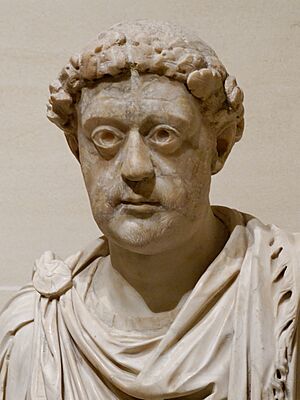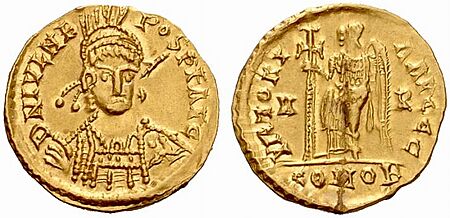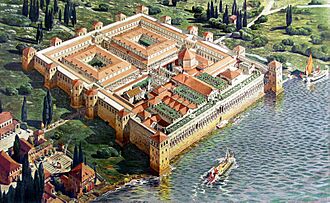Julius Nepos facts for kids
Quick facts for kids Julius Nepos |
|
|---|---|

Solidus of Julius Nepos, marked:
dn ivl nepos p f avc |
|
| Roman emperor in the West | |
| In Italy | 24 June 474 – 28 August 475 |
| Predecessor | Glycerius |
| Successor | Romulus Augustulus |
| In Dalmatia | 28 August 475 – 9 May 480 |
| Successor | position abolished (Zeno in the East) |
| Born | Dalmatia |
| Died | 9 May 480 Near Salona |
| Spouse | Niece of Leo I |
| Dynasty | Leonid |
| Father | Nepotianus |
| Mother | Sister of Marcellinus |
| Religion | Chalcedonian Christianity |
Julius Nepos (died 9 May 480) was a Roman emperor who ruled the Western Roman Empire from June 474 to August 475. After losing control of Italy, Nepos went back to his home region of Dalmatia. He still claimed to be the Western Roman Emperor, and the Eastern Roman Empire recognized him. He was killed in 480.
Some historians believe Nepos was the last true Western Roman Emperor. This is because he was the last one widely accepted by others. His successor in Italy, Romulus Augustulus, is often called the last emperor.
Contents
The Roman Empire's Situation
A Divided Empire

The huge Roman Empire became too big for one emperor to manage. So, it was often ruled by two emperors. By 395 AD, the empire was permanently split into Western and Eastern parts. Even so, Romans still thought of it as one empire with two rulers.
The Western Roman Empire was more rural and had a weaker economy. In the 5th century, it faced many invasions from Germanic groups. Rome was attacked in 410 and again in 455. Powerful barbarian generals started to control politics. They often chose weak emperors who would do what they wanted. In less than 20 years before Nepos, seven different emperors ruled the West. Real Roman control was only in Italy and parts of Gaul.
Nepos's Family and Background

Julius Nepos came from Dalmatia, a Roman province. Dalmatia was officially part of the Eastern Roman Empire. But it often acted like an independent region. Nepos's father was Nepotianus, a general. His uncle, Marcellinus, was a very important general. Marcellinus fought against the Vandals, a Germanic tribe.
Nepos married a noblewoman who was related to the Eastern Empress. She might have been the niece of Leo I, the Eastern Roman Emperor. After his uncle Marcellinus died, Nepos took over his role. He became the `magister militum Dalmatiae`, which means 'master of troops in Dalmatia'. This was a very high military position.
How Nepos Became Emperor
After the Western Emperor Anthemius died, and then his successor Olybrius, the Eastern Emperor Leo I believed he had the right to choose the next Western Emperor. However, a Burgundian king named Gundobad chose Glycerius as emperor in 473. Leo I was angry about this.
So, Leo I chose Nepos to lead an army to Italy and remove Glycerius. Nepos left for Italy in the spring of 474. He had the support of the new Eastern Emperor, Zeno. Nepos landed his army near Rome. He quickly removed Glycerius from power. On June 24, 474, Nepos was crowned Western Emperor in Rome. He was the last emperor to be crowned in Rome for many centuries. Zeno quickly recognized Nepos as the rightful Western Emperor.
Nepos's Reign
Emperor in Italy (474–475)
Nepos was first proclaimed `Caesar` (a junior emperor title) and then `Augustus` (the full emperor title). Glycerius did not fight back and was allowed to become a bishop. Nepos's rule was accepted by the Roman Senate and the people of Italy.
We don't have many records about Nepos's time as emperor. He minted coins in different cities in Italy. Coins also show that a Roman general in Gaul, Syagrius, accepted Nepos's rule. Nepos also made coins honoring Zeno and Leo II, showing his thanks to the Eastern Empire.
Nepos tried to make the Western Empire strong again. He may have stopped a Visigothic attack on Italy. He also made the Burgundians, another Germanic group, into `foederati`. This means they became allies of the empire.
Nepos focused on regaining control in Gaul. But the Western Empire was too weak to stop the Visigoths from taking over more land there. Nepos sent ambassadors to negotiate with the Visigothic king, Euric. The peace treaty meant giving up the Auvergne region to the Visigoths. This shocked many Romans in Gaul.
Nepos's weak position in Italy became even worse. This was because he failed to defeat the Visigoths. Also, Zeno, the Eastern Emperor, was briefly overthrown in Constantinople.
Nepos also had to deal with the Vandals, who controlled North Africa. They were attacking ships in the Mediterranean Sea. Because the Western Empire was so weak, Nepos had to accept Vandal rule over the lands they had already taken.
After his failures in Gaul, Nepos replaced his general, Ecdicius, with Orestes. Orestes was a skilled officer. Nepos told Orestes to lead an army against the Visigoths and rebellious Burgundians. But Orestes's army included many `foederati` troops. These troops were unhappy because the emperor would not give them land.
Orestes disobeyed Nepos's orders. Instead, he marched his army towards Ravenna, the capital of the Western Empire. Nepos could not stop Orestes. On August 28, 475, Nepos fled across the Adriatic Sea to Dalmatia. He had ruled Italy for only 14 months. Two months later, Orestes made his young son, Romulus Augustulus, emperor.
Exile in Dalmatia (475–480)
Not much is known about Nepos's time in Dalmatia. He never gave up his claim to be the Western Emperor. The Eastern Empire still recognized him, not Romulus Augustulus. Nepos hoped to get Italy back.
In 476, a barbarian general named Odoacer removed Romulus Augustulus from power. Odoacer became the first King of Italy. He sent the Western imperial symbols to Zeno in the East. Odoacer believed that from then on, there should only be one Roman Emperor, ruling from Constantinople.
Nepos also sent a message to Zeno, asking for help to regain Italy. Zeno told Odoacer that he should accept Nepos back as emperor. Zeno also said that Odoacer should get his title of `patrician` (a high Roman rank) from Nepos.
Odoacer only pretended to accept Nepos's rule. He minted gold coins in Nepos's name. But he did not help Nepos get his throne back. Nepos kept asking Zeno for help. But Zeno did not send military support or money.
In 479, Nepos might have gotten new hope. Theodoric, the king of the Ostrogoths, offered to help Nepos. But Nepos was killed on May 9, 480. He was at his villa near Salona, possibly Diocletian's Palace. He was killed by two of his generals, Ovida and Viator. Some think Glycerius, the emperor Nepos had removed, might have been involved. It's also possible Nepos was planning to invade Italy, and his supporters in Dalmatia did not want to join.
Nepos's death was violent and unexpected. But it did not get much attention at the time. Odoacer later invaded Dalmatia and killed Ovida. He used Nepos's murder as an excuse to take over the province. The Eastern Empire did not stop him. After Nepos died, Zeno became the sole Roman Emperor of the entire empire.
Nepos's Place in History
Romulus Augustulus is usually seen as the last Western Roman Emperor. But many historians argue that Nepos is the true last emperor. This is because Nepos continued to rule in Dalmatia with the imperial title. He also had the full recognition of the Eastern Empire until he was killed in 480.
Romulus Augustulus shares his name with the founder of Rome (Romulus) and its first emperor (Augustus). This might be why he is often remembered as the last emperor. Nepos also shares his first name, Julius, with Julius Caesar.
By the time Nepos died in 480, the Western Roman Empire was gone. Nepos had become an "unwanted old-fashioned thing." He was in the way for Odoacer, who wanted to expand into Dalmatia. He was also an embarrassment to Zeno, who could not fully support him. His death marked the end of Western emperors, but it was barely noticed at the time. Later, Eastern Roman historians did not even recognize Nepos's rule in Dalmatia as a real continuation of his imperial reign.
See also
 In Spanish: Julio Nepote para niños
In Spanish: Julio Nepote para niños





